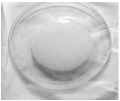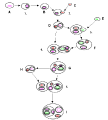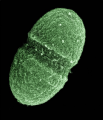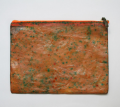m (Miga moved page GMU:BioArt/Bacteria and symbiotic relationships to GMU:BioArt WS15/Bacteria and symbiotic relationships) |
|||
| (34 intermediate revisions by the same user not shown) | |||
| Line 1: | Line 1: | ||
I love the fact that human genomes can be found in only about 10 percent of all the cells that occupy the mundane space I call my body; the other 90 percent of the cells are filled with the genomes of bacteria, fungi, protists, and such, some of which play in a symphony necessary to my being alive at all, and some of which are hitching a ride and doing the rest of me, of us, no harm. — | <i>I love the fact that human genomes can be found in only about 10 percent of all the cells that occupy the mundane space I call my body; the other 90 percent of the cells are filled with the genomes of bacteria, fungi, protists, and such, some of which play in a symphony necessary to my being alive at all, and some of which are hitching a ride and doing the rest of me, of us, no harm.</i> — Donna Haraway | ||
==Synthesis of bacterial cellulose/paper from kombucha scoby== | ==Synthesis of bacterial cellulose/paper from kombucha scoby== | ||
"A symbiotic colony of bacteria and yeast, or SCOBY is a popular term (rather than scientific) used to refer to mixed cultures of bacteria and yeast present during production of kombucha. The term "colony" in the name is a scientific misnomer, because it implies a group of genetically identical or nearly identical organisms living together." (wikipedia 2015) | |||
Yeast and bacteria commonly found in SCOBY include: Acetobacter species, Gluconacetobacter species, Saccharomyces species, Gluconacetobacter xylinus and other bacteria and yeasts. | |||
We will try isolating Gluconacetobacter xylinus, anaerobic bacteria that ferments alcohols and produces cellulose. | |||
* | * anahatabalance (2007) | ||
* | * openwetware (2015) | ||
* Kulkarni, P.K., Anil Dixit, S., Singh, U.B. (2012) | |||
<gallery> | <gallery> | ||
| Line 18: | Line 21: | ||
Image:IMG_0287.png | Image:IMG_0287.png | ||
Image:IMG_2440.png | Image:IMG_2440.png | ||
Image:Bacterial_pellicle_grown_in_herstin-schramm_nutrient_medium.png|Bacterial pellicle grown in herstin-schramm nutrient medium (Kulkarni et al 2012) | |||
</gallery> | </gallery> | ||
==Human microbiota== | ==Human microbiota== | ||
"Microbes inhabit just about every part of the human body, living on the skin, in the gut, and up the nose. Sometimes they cause sickness, but most of the time, microorganisms live in harmony with their human hosts, providing vital functions essential for human survival." (NIH 2012) | |||
"The human body contains trillions of microorganismsoutnumbering human cells by 10 to 1. Because of their small size, however, microorganisms make up only about 1 to 3 percent of the body's mass (in a 200pound adult, that's 2 to 6 pounds of bacteria), but play a vital role in human health." (NIH 2012) | |||
"Where doctors had previously isolated only a few hundred bacterial species from the body, HMP researchers now calculate that more than 10,000 microbial species occupy the human ecosystem." (NIH 2012) | |||
“During the course of the evolution of mitosis, photosynthetic plastids (themselves derived from prokaryotes) were symbiotically acquired by some of these protozoans to form the eukaryotie algae and the green plants.” (Margulis 1966) | “During the course of the evolution of mitosis, photosynthetic plastids (themselves derived from prokaryotes) were symbiotically acquired by some of these protozoans to form the eukaryotie algae and the green plants.” (Margulis 1966) | ||
“Symbiogenesis, or endosymbiotic theory, is an evolutionary theory that explains the origin of eukaryotic cells from prokaryotes (1.5 billion years ago). It states that several key organelles of eukaryotes originated as a symbiosis between separate single-celled organisms (Lynn Margulis theory)” ( | “Symbiogenesis, or endosymbiotic theory, is an evolutionary theory that explains the origin of eukaryotic cells from prokaryotes (1.5 billion years ago). It states that several key organelles of eukaryotes originated as a symbiosis between separate single-celled organisms (Lynn Margulis theory)” (Haraway 2008) | ||
“Species interdependence is the name of the worlding game on earth, and that game must be one of response and respect. That is the play of companion species learning to pay attention. Not much is excluded from the needed play, not technologies, commerce, organisms, landscapes, peoples, practices.” ( | “Species interdependence is the name of the worlding game on earth, and that game must be one of response and respect. That is the play of companion species learning to pay attention. Not much is excluded from the needed play, not technologies, commerce, organisms, landscapes, peoples, practices.” (Haraway 2008) | ||
“Organisms are ecosystems of genomes, consortia, communities, partly digested dinners, mortal boundary formations.” ( | “Organisms are ecosystems of genomes, consortia, communities, partly digested dinners, mortal boundary formations.” (Haraway 2008) | ||
“Because I become with dogs, I am drawn into the multispecies knots that they are tied into and that they retie by their reciprocal action. My premise is that touch ramifies and shapes accountability.” (Haraway 2008) | “Because I become with dogs, I am drawn into the multispecies knots that they are tied into and that they retie by their reciprocal action. My premise is that touch ramifies and shapes accountability.” (Haraway 2008) | ||
<gallery> | <gallery> | ||
Image:Enterococcus_faecalis_bacterium,_which_lives_in_the_human_gut.png| Enterococcus faecalis bacterium, which lives in the human gut. Source: wikipedia | Image:A representation of the endosymbiotic theory; wikipedia.png|A representation of the endosymbiotic theory. Source: wikipedia.org | ||
Image:Enterococcus_faecalis_bacterium,_which_lives_in_the_human_gut.png| Enterococcus faecalis bacterium, which lives in the human gut. Source: wikipedia.org | |||
</gallery> | </gallery> | ||
| Line 43: | Line 53: | ||
“Kin is an assembling sort of word. All critters share a common “flesh,” laterally, semiotically, and genealogically.” (Haraway 2015) | “Kin is an assembling sort of word. All critters share a common “flesh,” laterally, semiotically, and genealogically.” (Haraway 2015) | ||
== | ==Projects== | ||
* Henk Jonkers. Bioconcrete. http://www.citg.tudelft.nl/en/research/projects/self-healing-concrete , http://www.tudelft.nl/en/current/latest-news/article/detail/zelfherstellend-biobeton-tu-delft-genomineerd-voor-european-inventor-award/ | |||
* Oron Catts. Victimless Leather. http://www.tca.uwa.edu.au/vl/images.html | |||
* Suzanne Lee. Eco Textile Fashion http://www.designboom.com/design/suzanne-lee-eco-textile-fashion/ | |||
* Emma van der Leest. Clutch Bag. http://emmavanderleest.com/portfolio/biocouture-ltd-clutch-bag-by-emma/ | |||
* Dr. Simon Park, Worlds First Bacteria Grown Book. http://thecreatorsproject.vice.com/blog/worlds-first-bacteria-grown-book | |||
<gallery> | |||
Image:IMG_2028.png|Ginger Krieg Dosier. Biobrick (Myers 2013) | |||
Image:IMG_2029.png|Henk Jonkers. Bioconcrete (Myers 2013) | |||
Image:IMG_2577.png|Eduardo Mayoral Gonzales. Bioluminiscent Devices (Myers 2013) | |||
Image:IMG_2578.png|Anna Bredle. Exploring the invisible (Myers 2013) | |||
</gallery> | |||
<gallery> | |||
Image:emma-van-der-leest-clutch01.png|Emma van der Leest. Clutch Bag. Source: emmavanderleest.com | |||
Image:oron-catts-victimless_leather02.png|Oron Catts. Victimless Leather. Source: tca.uwa.edu.au | |||
Image:suzanne-lee-BioBiker_Jacket.png|Suzanne Lee. BioBiker Jacket. Source: designboom.com | |||
Image:Worlds-first-bacteria-grown-book.png|Simon Park. World’s First Bacteria-Grown Book. Source thecreatorsproject.vice.com | |||
</gallery> | |||
==Bibliography== | ==Bibliography== | ||
* | * anahatabalance (2007). Kombucha Brewing Instructions. Available at http://www.instructables.com/id/Kombucha-Brewing-Instructions/ (accessed 29 November 2015) | ||
* [http://environmentalhumanities.org/arch/vol6/6.7.pdf Donna | * [http://projectlamar.com/media/harrawayspecies.pdf Haraway, Donna (2008) WHEN SPECIES MEET] | ||
* [http:// | * [http://environmentalhumanities.org/arch/vol6/6.7.pdf Haraway, Donna (2015). "Anthropocene, Capitalocene, Plantationocene, Chthulucene: Making Kin" in Environmental Humanities, vol. 6, pp. 159-165] | ||
* [http://web.gps.caltech.edu/classes/ge246/endosymbiotictheory_marguli.pdf Lynn | * [http://rebekkahehn.de/wp-content/uploads/2015/07/Biofabrication_PDF.pdf Hehn, Rebekka (2015). BioFabrication] | ||
* [http://scialert.net/fulltext/?doi=ajdd.2012.72.86&org=10 Kulkarni, P.K., Anil Dixit, S., Singh, U.B. (2012). Evaluation of Bacterial Cellulose Produced Form Acetobacter xylinum as Pharmaceutical Excipient] | |||
* [http://web.gps.caltech.edu/classes/ge246/endosymbiotictheory_marguli.pdf Margulis, Lynn (1966). "On the Origin of Mitosing Cells" in J. Theoret. Biol. (1967) 14, 225-274 ] | |||
* Myers, William (2013). Bio Design, Thames & Hudson | |||
* [http://www.nih.gov/news-events/news-releases/nih-human-microbiome-project-defines-normal-bacterial-makeup-body NIH (2012) NIH Human Microbiome Project defines normal bacterial makeup of the body] | |||
* openwetware (2015). Acetobacter Xylinum Culture. Available at http://openwetware.org/wiki/Acetobacter_Xylinum_Culture (Accessed 29 November 2015) | |||
* wikipedia (2015). SCOBY. Available at https://en.wikipedia.org/wiki/SCOBY (Accessed 29 November 2015) | |||
Latest revision as of 15:52, 10 October 2017
I love the fact that human genomes can be found in only about 10 percent of all the cells that occupy the mundane space I call my body; the other 90 percent of the cells are filled with the genomes of bacteria, fungi, protists, and such, some of which play in a symphony necessary to my being alive at all, and some of which are hitching a ride and doing the rest of me, of us, no harm. — Donna Haraway
Synthesis of bacterial cellulose/paper from kombucha scoby
"A symbiotic colony of bacteria and yeast, or SCOBY is a popular term (rather than scientific) used to refer to mixed cultures of bacteria and yeast present during production of kombucha. The term "colony" in the name is a scientific misnomer, because it implies a group of genetically identical or nearly identical organisms living together." (wikipedia 2015)
Yeast and bacteria commonly found in SCOBY include: Acetobacter species, Gluconacetobacter species, Saccharomyces species, Gluconacetobacter xylinus and other bacteria and yeasts.
We will try isolating Gluconacetobacter xylinus, anaerobic bacteria that ferments alcohols and produces cellulose.
- anahatabalance (2007)
- openwetware (2015)
- Kulkarni, P.K., Anil Dixit, S., Singh, U.B. (2012)
Human microbiota
"Microbes inhabit just about every part of the human body, living on the skin, in the gut, and up the nose. Sometimes they cause sickness, but most of the time, microorganisms live in harmony with their human hosts, providing vital functions essential for human survival." (NIH 2012)
"The human body contains trillions of microorganismsoutnumbering human cells by 10 to 1. Because of their small size, however, microorganisms make up only about 1 to 3 percent of the body's mass (in a 200pound adult, that's 2 to 6 pounds of bacteria), but play a vital role in human health." (NIH 2012)
"Where doctors had previously isolated only a few hundred bacterial species from the body, HMP researchers now calculate that more than 10,000 microbial species occupy the human ecosystem." (NIH 2012)
“During the course of the evolution of mitosis, photosynthetic plastids (themselves derived from prokaryotes) were symbiotically acquired by some of these protozoans to form the eukaryotie algae and the green plants.” (Margulis 1966)
“Symbiogenesis, or endosymbiotic theory, is an evolutionary theory that explains the origin of eukaryotic cells from prokaryotes (1.5 billion years ago). It states that several key organelles of eukaryotes originated as a symbiosis between separate single-celled organisms (Lynn Margulis theory)” (Haraway 2008)
“Species interdependence is the name of the worlding game on earth, and that game must be one of response and respect. That is the play of companion species learning to pay attention. Not much is excluded from the needed play, not technologies, commerce, organisms, landscapes, peoples, practices.” (Haraway 2008)
“Organisms are ecosystems of genomes, consortia, communities, partly digested dinners, mortal boundary formations.” (Haraway 2008)
“Because I become with dogs, I am drawn into the multispecies knots that they are tied into and that they retie by their reciprocal action. My premise is that touch ramifies and shapes accountability.” (Haraway 2008)
Chthulucene
Chthulucene is a multispecies assemblages that include people within past, present, and future. The idea of Haraway is that Anthropocene marks rather a boundary and not an epoch as widely accepted.
“Of course, from the start the greatest planetary terraformers (and reformers) of all have been and still are bacteria and their kin, also in inter/intra-action of myriad kinds (including with people and their practices, technological and otherwise).” (Haraway 2015)
“Kin is an assembling sort of word. All critters share a common “flesh,” laterally, semiotically, and genealogically.” (Haraway 2015)
Projects
- Henk Jonkers. Bioconcrete. http://www.citg.tudelft.nl/en/research/projects/self-healing-concrete , http://www.tudelft.nl/en/current/latest-news/article/detail/zelfherstellend-biobeton-tu-delft-genomineerd-voor-european-inventor-award/
- Oron Catts. Victimless Leather. http://www.tca.uwa.edu.au/vl/images.html
- Suzanne Lee. Eco Textile Fashion http://www.designboom.com/design/suzanne-lee-eco-textile-fashion/
- Emma van der Leest. Clutch Bag. http://emmavanderleest.com/portfolio/biocouture-ltd-clutch-bag-by-emma/
- Dr. Simon Park, Worlds First Bacteria Grown Book. http://thecreatorsproject.vice.com/blog/worlds-first-bacteria-grown-book
Bibliography
- anahatabalance (2007). Kombucha Brewing Instructions. Available at http://www.instructables.com/id/Kombucha-Brewing-Instructions/ (accessed 29 November 2015)
- Haraway, Donna (2008) WHEN SPECIES MEET
- Haraway, Donna (2015). "Anthropocene, Capitalocene, Plantationocene, Chthulucene: Making Kin" in Environmental Humanities, vol. 6, pp. 159-165
- Hehn, Rebekka (2015). BioFabrication
- Kulkarni, P.K., Anil Dixit, S., Singh, U.B. (2012). Evaluation of Bacterial Cellulose Produced Form Acetobacter xylinum as Pharmaceutical Excipient
- Margulis, Lynn (1966). "On the Origin of Mitosing Cells" in J. Theoret. Biol. (1967) 14, 225-274
- Myers, William (2013). Bio Design, Thames & Hudson
- NIH (2012) NIH Human Microbiome Project defines normal bacterial makeup of the body
- openwetware (2015). Acetobacter Xylinum Culture. Available at http://openwetware.org/wiki/Acetobacter_Xylinum_Culture (Accessed 29 November 2015)
- wikipedia (2015). SCOBY. Available at https://en.wikipedia.org/wiki/SCOBY (Accessed 29 November 2015)


















